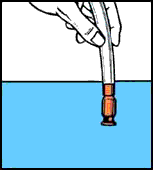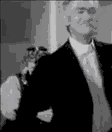
My guest essay "Psychotronic GIFs," for Paddy Johnson's IMG MGMT series of blog posts, is up this morning: please go siphon it up, that is, give it a look.

My guest essay "Psychotronic GIFs," for Paddy Johnson's IMG MGMT series of blog posts, is up this morning: please go siphon it up, that is, give it a look.
"Samplerette" [mp3 removed]
The samples from the Reaktor "Massive" groovebox are generic club stabs (heavily reverbed piano and organ chords, etc.) that are supposed to be further deformed by the software but I exported the map and have just been writing tunes for the samples. The compositional principle is obedience to a certain innate structure that is revealed through working (including "necessary" variations and puns).
Have decided to resume Twitter posting. Stopped because they limited their archive to ten pages. Was saving everything and will continue to do that on a regular basis. It is useful as a diary and virtual notepad.
So, first installment of saved posts: March to June 2008 (reverse chron. order)
Update, Feb 2011: Changed the URL. Am gradually putting up all my twitter posts as HTML pages.
BITMAP: As Good As New
catalog of the exhibition: [841 KB .pdf]
The Leonard Perlstein Gallery
Drexel University
Philadelphia PA
vertexList Gallery
New York, NY
The catalog essay "Bitmap and Vector," by "BITMAP" curator Marcin Ramocki, explores the two main ways of making images digitally. Ramocki posits them as central metaphors, or markers, in hyper-stimulated, hyper-simulated (i.e., post-Baudrillardian) visual culture. The essay is eloquent and informative but seems to be leading up to a conclusion rather at odds with the artists chosen for the exhibit:
"The vector is the more revolutionary visual unit so the artists in this show follow the path of retrenchment."
Kidding, sort of, he doesn't really say that, but Ramocki's gallery is called vertexList, which is a term from vector graphics, and there is a notable uptick in his prose excitement when describing those graphics that is perhaps lacking in his description of stodgy old horizontal-and-vertical, reality-based bitmaps. (In brief, bitmaps are grids of dots called pixels, similar to photographic "grain," while vector imaging is based on drawing curves to define shapes. Photoshop is bitmap based and Illustrator and Flash are vector based. The latter use "handles" to draw Bezier curves defined by points called "vertices.")
Here's where Ramocki really gets cooking:
Vector image essentially does away with the necessity of the "real" and the photo-optical referent. It is a child of a purely virtual formation process and a "perfect simulation," to continue the Baudrillard reference. Unlike the Photoshop filtering process that "tricks" the photo to look a certain way via a chain of intricate algorithms, a vector is infinitely pliable and non-photographic--any vertex can be repositioned along with the handles at any point. There is no claim of optical proximity to some existing universe; there is only design for its own sake.
This blog admits a certain bias for bitmaps (because they are dumb) and basic ignorance regarding vector graphics. I admired the vector-inspired "graphics revolution" of the '90s, as wrought by such collectives as Designers Republic and Buro Destruct, but still prefer the look of GIFs to the ultra-smoothness of Flash and favor the output of crappy pixel-based imaging programs such as MSPaint and Paintbrush over the sleek gradient fodder of Adobe Illustrator.
"BITMAP" has about 30 artists working with pixel-based reduction, craft, and image-dismantling. One hopes that Ramocki can one day round up all the artists bending time, space, and human understanding with vector (Paper Rad?) for a companion show: "Bitmap vs Vector: Who Will Win?"

1. Data is Nature has links to interesting papers (in PDF and non-PDF form) on synthesthesia arts, including historical attempts to render sound waves as visual patterns (illustrated with gorgeous Deco drawings such as the one Oskar Fischinger is holding in a vintage photo) and a connection between Vasarely paintings and music.
2. Matt Stoller offers an interesting way to rebut arguments that "the free market is always right" (we know it isn't, hence McDonald's and Pixar movies). In his post he applies the economics of the "lemon theory" of used cars to some recent southern California legislation to ban fast food. The comments have rebuttals to his rebuttal.
3. Nice hiphop instrumental mp3 "Introducing...Intro" [link] from cratekings, recommended by disquiet.
4. For some reason Jed Clampett dances at half speed on Internet Explorer and normal speed on Firefox. We need some dance standards here.